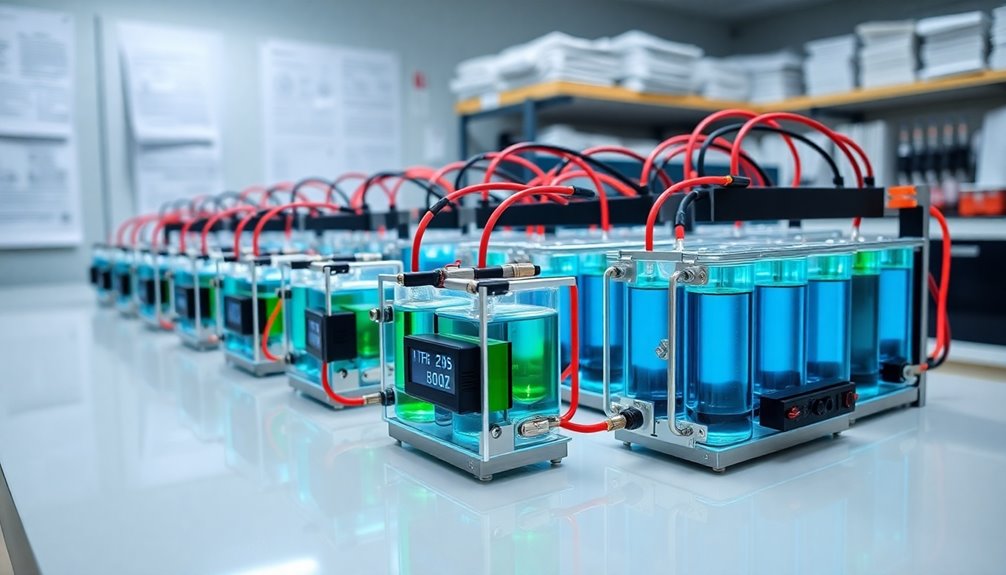Zinc-based flow battery management systems are gaining traction due to their eco-friendly designs and cost-effectiveness. They've shown impressive energy efficiency, reaching up to 85%, making them suitable for both residential and grid applications. However, challenges like dendrite formation and cation crossover still hinder performance. With ongoing innovations to enhance stability and operational capabilities, there's much to explore about their impact on modern energy storage solutions. Discover how these systems could shape the future of energy.
Key Takeaways
- Zinc-based flow batteries utilize eco-friendly materials, lowering environmental impact and supporting sustainable energy storage solutions.
- Cost-effective manufacturing processes make zinc flow batteries more affordable for residential and grid-scale applications.
- Performance metrics indicate high energy density and efficiency levels up to 85%, meeting modern energy storage demands.
- Key challenges include dendrite formation and cation crossover, which hinder cycle stability and require innovative solutions for improvement.
- Recent innovations, like chelated Zn(PPi)²⁶⁻ negolyte, are enhancing performance and preventing issues, driving market growth, especially in the Asia-Pacific region.

Zinc-based flow batteries are revolutionizing energy storage with their eco-friendly design and cost-effectiveness. You'll appreciate that these batteries utilize non-toxic and recyclable materials, which not only reduces environmental impact but also makes them a sustainable choice for energy storage.
With zinc being abundant and inexpensive, the manufacturing processes are simpler, resulting in lower costs compared to other battery technologies. This combination of environmental benefits and cost efficiency positions zinc-based flow batteries as a viable option for both residential and grid-scale applications.
Zinc-based flow batteries offer an eco-friendly and cost-effective energy storage solution for both homes and the grid.
As you delve into the performance metrics, you'll find that these batteries boast high energy density and can achieve energy efficiency levels of up to 85%. This makes them suitable for large-scale energy storage, which is crucial in today's energy landscape. Moreover, the aqueous zinc flow battery market is projected to reach $2.15 billion by 2034, reflecting the growing demand for these systems.
However, challenges like dendrite formation and cation crossover can hinder performance and reduce cycle stability. You might notice that zinc dendrites can cause short circuits, which is a major concern for practical applications, especially at high current densities.
Fortunately, ongoing innovations are addressing these issues. For example, the development of chelated Zn(PPi)²⁶⁻ negolyte effectively prevents dendrite growth and Zn²⁺ crossover. Modified electrodes and the introduction of additives like chromium also suppress dendrite formation, enhancing battery performance.
These advancements are paving the way for improved operational capabilities, allowing you to feel more confident in the reliability of zinc-based flow batteries.
The market for these batteries is projected to grow significantly, driven by the urgent need for sustainable energy storage solutions. As the Asia-Pacific region leads in this growth due to rapid industrialization and renewable energy investments, you can expect to see continued advancements and adoption of zinc-based flow batteries.
Embracing this technology means supporting a cleaner, more efficient energy future.
Frequently Asked Questions
What Are the Main Advantages of Zinc-Based Flow Batteries?
Zinc-based flow batteries offer several advantages.
You'll find they use low-cost, abundant materials, making them economically viable. Their non-toxic and recyclable components align with environmental regulations, ensuring safety and sustainability.
Technologically, they boast high energy density and durability, with modular designs for scalability. Plus, they minimize risks like thermal runaway, providing a safer alternative to lithium-ion batteries.
With growing demand, these batteries are poised for significant market expansion in the coming years.
How Do Zinc-Based Flow Batteries Compare to Lithium-Ion Batteries?
Zinc-based flow batteries and lithium-ion batteries present a striking contrast.
While lithium-ion batteries dominate with higher energy density and widespread consumer use, zinc flow batteries shine in scalability and longevity, lasting over 20 years.
You'll find zinc batteries safer, with minimal thermal runaway risk, making them ideal for grid-scale applications.
Although their efficiency is lower and initial costs can be higher, their long-term value and potential for renewable energy integration are compelling advantages.
What Is the Lifespan of a Zinc-Based Flow Battery?
The lifespan of a zinc-based flow battery can vary significantly based on its design and operational conditions.
Typically, you can expect a warranted electrode stack lifetime or a specific number of cycles before replacement's necessary.
Factors like zinc plating quality and dendrite formation directly affect performance.
Regular maintenance is essential to optimize longevity, and if kept dry, the battery can remain fully discharged without self-discharge occurring, extending its overall lifespan.
Are There Any Safety Concerns With Zinc-Based Flow Batteries?
You might think zinc-based flow batteries are entirely safe, but there are some serious safety concerns.
Dendrite formation can cause short circuits, while hydrogen gas evolution affects efficiency and lifespan.
High pH levels lead to unwanted compounds that clog membranes, and shunt currents create side reactions that can compromise performance.
Keeping a close eye on electrolyte flow rates is essential to prevent issues that could jeopardize both safety and efficiency.
How Are Zinc-Based Flow Batteries Recycled After Use?
When you recycle zinc-based flow batteries, you'll need to follow a specialized process due to their unique components.
First, you break down the battery to extract reusable materials, which is crucial for minimizing environmental impact.
Since their chemistry is complex, careful handling is essential to avoid contamination.
Advanced technologies are often required to efficiently recover valuable materials, and ongoing research aims to improve recycling methods to ensure sustainability in this area.
Conclusion
In conclusion, zinc-based flow battery management systems are like the unsung heroes of energy storage, quietly powering the future. They offer unique advantages such as scalability and cost-effectiveness, but challenges remain in efficiency and longevity. By addressing these issues, we can unlock their full potential. As the demand for sustainable energy solutions grows, refining these systems could lead to breakthroughs that energize our grid and propel us toward a greener tomorrow.






